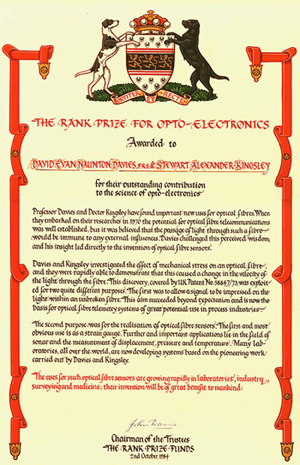British geophysicist Dan McKenzie of Cambridge University has won this year’s Crafoord prize – worth US$500 000 – for his pioneering studies of plate tectonics. Awarded by the Royal Swedish Academy of Sciences, the prize recognizes research in areas not covered by the Nobel Prizes. Meanwhile, the Rank Prize for Optoelectronics has been awarded to three groups for the invention of fibre Bragg gratings, optical coherence tomography and ‘vertical cavity’ lasers.

McKenzie proposed in the 1960s that the Earth’s crust consisted of rigid, mobile ‘plates’ – a theory now central to geology – and went on to study how these plates interact to produce earthquakes and volcanoes. McKenzie’s later investigations of the effect of Earth’s gravity on the structure of its crust were extended when he collaborated with NASA scientists to study the surface of Venus from gravity data collected by the Magellan mission in the 1990s. He also identified the mechanisms behind certain surface features on Mars. McKenzie will receive the prize from the King of Sweden on 18 September in Stockholm.
The Rank Prize goes to three teams who each share around £40 000 for their contributions to optoelectronics. Ken Hill’s team at the Communications Research Centre in Ottawa, Canada, Brian Garside’s group at McMaster University, Canada, and Gerald Meltz, William Morey and colleagues at the United Technologies Research Center in Connecticut, US, are recognized for the invention of fibre Bragg gratings.
Bragg gratings are widely used in telecommunications systems to increase the capacity of optical fibres. Signals with different wavelengths can travel through an optical fibre simultaneously, and this multiplies the capacity of the fibre by the number of wavelengths used. Bragg gratings are used to shift the wavelengths of transmitted signals to maximize the capacity of the fibre, and also to recover the original signals at the receiving end.
James Fujimoto and Eric Swanson of the Massachusetts Institute of Technology, and Carmen Puliafito of the New England Eye Center in Boston, receive the award for the development of optical coherence tomography. This technique – which works by analysing light scattered from biological tissue – is already used to diagnose eye disorders, and could soon be used to detect cancer and image the gastrointestinal tract.
Kenichi Iga of the Tokyo Institute of Technology and Robert Burnham and Donald Scifres of Xerox Corporation, are rewarded for the development of vertical cavity surface emitting lasers, or VCSELs. Amplified light is emitted from a VCSEL through a specially engineered reflector on top of the laser cavity, in contrast to conventional lasers, which emit light from the side of the cavity. VCSELs are more compact and easier to manufacture then ‘edge-emitting’ lasers and are widely used in telecommunications and optical data storage.
The Rank Prizes will be awarded on 25 February at the Royal Society of Medicine in London.




